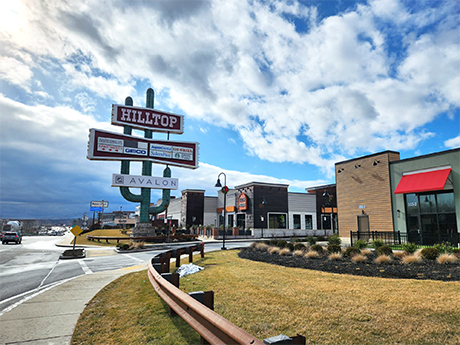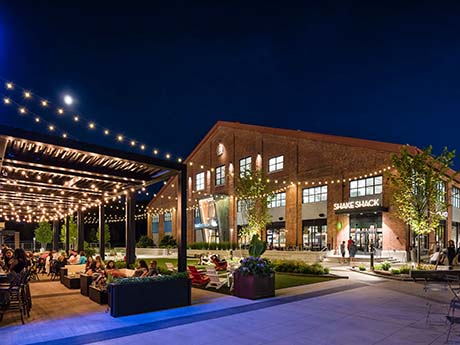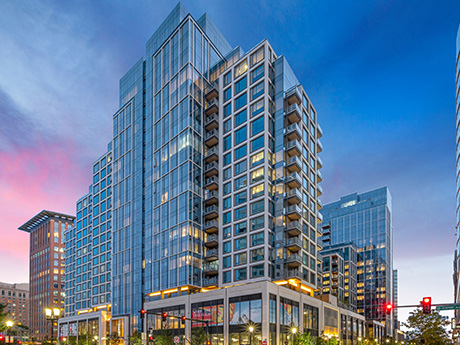By Ben Starr, partner at Atlantic Retail As the retail real estate industry seeks to understand what may lie ahead in 2023, a study of the wild ride it took in 2022 will likely produce the best clues. As early as March of last year, it was clear that 2022 would be a year of activity like none of the prior 15. While headlines through the spring and summer emphasized a run-up in consumer prices and a recession hovering on the back of interest rate hikes, users of retail space intensified their pursuits of new opportunities, unbowed by the looming economic clouds. Everyone — traditional commodity retailers, direct-to-consumer concepts, restaurants, fitness users, medical and other services — was chasing deals. Whether small or large or in primary, secondary or tertiary markets, activity heated up with each new month. Reflecting Larger Trends With its dense middle-class demographics, close proximity to Boston and high traffic counts, Saugus has historically been in high demand among category killers as well as high-profile service and restaurant operators. Though its local mall, Square One, has struggled as larger, more regional malls rose in upscale neighboring markets, the heavily traveled Route 1 corridor has remained one of …
Massachusetts
By Taylor Williams As an exceptionally dense, compact market that’s only bordered by land on three sides, metro Boston and its brick-and-mortar retail sectors have long been subject to shortages of quality retail space. Even during the height of the pandemic, when some retailers and restaurants went under and sent vacated space back to the market, prime locations were quickly reabsorbed. As it did nationally during the shutdown of the U.S. economy, rent growth in Boston’s retail market subsided temporarily, only to rebound quickly via pent-up demand. Now, the economy is seemingly on the verge of recession, and consumers’ disposable incomes are being severely stretched by 40-year inflationary highs. Yet Boston’s healthy proportion of young people and strong growth in high-paying industries like tech, healthcare and life sciences still have numerous retail users and brokers feeling bullish on the market. But even the most aggressive and well-thought-out expansion plans can fall flat in the absence of good physical space in which to grow. A Tight Market According to data compiled by Newmark, there is roughly 500,000 square feet of pure-play retail space currently under construction throughout the Boston area. While construction timelines are fluid, the full-service real estate firm estimates …
By Becky Bedwell, vice president of development, Cottonwood Group As one of Boston’s fastest-growing and most dynamic areas, the Seaport District has gotten a lot of attention as it has undergone a multitude of transformations over the past 150 years. The area has evolved from a bustling railyard and shipping area in the early 20th century to a no-man’s land of parking lots in the 1990s to its most recent iteration: The Innovation District. While the spotlight is only growing brighter as several high-profile residential and mixed-use projects come on line in this distinctive and in-demand neighborhood, the headlines tell only part of the story. The Seaport District’s seemingly sudden emergence is the result of more than a decade of development and over $22 billion in public funding — efforts that have helped draw hundreds of new businesses and support a growing list of noteworthy developments. The challenges faced and opportunities realized by developers in this part of town reveal some important truths about what it takes to create great civic spaces and successful multifamily developments — not just in this city and this area, but in urban communities around the country. What follows are some best practices, consideration and …
By Taylor Williams The business of trading retail properties is booming across the greater Boston area, and the combination of cheap capital, a desire to recoup lost business and potential changes in tax law are prompting buyers and sellers alike to transact at a frenetic pace. As is often the case in times of robust investment sales activity, low interest rates are the straw that stirs the drink. At its latest meeting in June, the Federal Reserve opted to hold the federal funds rate — the short-term rate by which lending between financial institutions is priced — at a target range of 0 to 0.25 percent. The Fed cut rates by 100 basis points to this target range in March 2020 in response to the COVID-19 outbreak and has kept them there ever since. A fiscal policy defined by record-low rates is persisting even in the face of inflation, which hit its highest mark in 13 years when the U.S. Consumer Price Index rose by 5.4 percent in June 2021 relative to June 2020. Economists have cited sustained injections of federal stimulus and relief money and elevated government spending in response to the pandemic as the key drivers of this …
By Brendan Carroll, director of research, Cushman & Wakefield The rapid emergence of greater Boston in the first two decades of the 21st century as a global center of advanced, technology-assisted biology has been followed by an even faster rate of growth since the start of the new decade. We have reached a critical mass in the greater Boston market, where we have developed a combination of skills, institutions and collaboration between companies that is supported and financed by an investor base that is qualified to evaluate the potential efficacy of new innovations. This landscape has created a self-propagating ecosystem for development and absorption of life sciences properties. The region’s large inventory of lab space has also evolved as a driver of new users into the market as biotechnology groups increasingly focus on speed to market for promising scientific breakthroughs. In response to these drivers, the inventory of biotechnology-focused laboratory space in greater Boston, which eclipsed 20 million square feet in 2016, is now on pace to reach 30.7 million square feet by 2023. Furthermore, the current inventory levels will likely approach and surpass 40 million square feet this decade, as a sizable set of projects are expected to move …
By Simon Butler, vice chairman, CBRE; Biria St. John, vice chairman, CBRE; John McLaughlin, senior vice president, CBRE; and Colleen Pentland Lally, vice president, CBRE As we emerge from pandemic-era lockdowns and restrictions, Boston’s multifamily market is proving once again to be extremely resilient. With businesses, offices, restaurants and leisure activities rapidly returning to normal, both the overall economy and multifamily fundamentals are rebounding with a velocity that has far outpaced industry expectations to date. Throughout the winter and spring of 2021, job recovery has been swift in the metro Boston region, with employment levels now over 92 percent of pre-pandemic levels, according to the Bureau of Labor Statistics (BLS). The positive momentum is translating into remarkable near-term recovery and growth within the multifamily market. The overall health, stability and resiliency of the greater Boston region is a direct result of the highly skilled and educated labor force, which continues to attract high-paying jobs across the technology, medical, pharmaceutical and educational sectors, among others. Metro Boston is also home to the largest life sciences cluster in the nation, where the local economy has benefited and will continue to benefit from the stability and growth in this industry. In fact, according …
By Brian Pinch, managing director, Newmark On a national level, the industrial market continues to perform well amidst the coronavirus-induced market correction that has impacted other asset classes. Industrial fundamentals ended 2020 on solid footing, with outsized demand, rising rents and a healthy supply pipeline. Despite the impacts of COVID-19, key logistics hubs like Los Angeles and the Inland Empire are doing well, as are smaller metros like Boston. The continued shift towards e-commerce and online shopping, as well as a greater emphasis on strong distribution networks and supply chains, are driving activity within tertiary markets as well. Combined with sustained cap rate compression, such positive fundamentals have led to increased investor interest in the industrial asset class. Capital that was previously allocated for other property types is now flowing into the industrial market, and low interest rates are giving buyers increased purchasing power. As a result, pricing for industrial product continues to climb across many metros, including greater Boston. In fact, greater Boston’s industrial market maintains one of the most dynamic investment landscapes in the country, as historically tight vacancies and rapidly rising rents attract record levels of capital. Though the metro-wide vacancy rate is below 6 percent — …
By Steve Callahan Jr., vice president of business development, Callahan Construction Managers Despite the turmoil caused by the COVID-19 pandemic, Boston has experienced significant job growth over the last 12 to 18 months in the life sciences, healthcare, technology and finance sectors. The health of these industries will require that employees in these fields have access to much needed, reasonably priced housing as companies continue to grow and build, creating more local jobs. Demand for rental housing over the past few years has been mostly driven by millennials who work in these fields. This trend is expected to continue as young professionals in these sectors no longer need to commute to the office by virtue of the pandemic forcing many companies to adopt work-from-home programs. In addition, these renters are seeking to upgrade to larger units with more modern amenities and access to outdoor spaces and activities. More than 7,100 units were delivered last year in the Boston area, only slightly less than the cyclical high of nearly 7,500 apartments added in 2018. However, most projects that were either started or delivered in 2020 were aimed at lifestyle renters in or near Boston’s city center. This could spell trouble for …
By Brendan Carroll, research director, Cushman & Wakefield Through the first three quarters of 2020, the Boston life sciences market is seeing record occupancy, a continuation of large new-building leases, stable rents at record levels, high levels of pre-committed new construction and an insatiable appetite for inventory in new submarket clusters. Cushman & Wakefield defines laboratory properties as facilities optimized for the physical scientific research of biotechnology products. COVID-19’s Impact Following a pause of leasing activity in the first quarter of 2020, lease negotiations for laboratory facilities resumed quickly in the second quarter, hitting a level that commercial office properties have still yet to see. While optimism quickly returned for the region’s office-using businesses, widespread execution of remote office-using job functions has proven to be more effective for many of these workforces than market leaders previously envisioned. The consensus among real estate observers suggests a long-term decrease in the percent of in-office workers for traditional office-using functions. However, the importance of the continued use of physical spaces for biotechnology research will not be affected, as this function cannot be accommodated through current and easily envisioned remote work practices. These are highly specialized jobs performed by employees with highly targeted skill …
By Alex Patton Retail real estate investors in Boston are cautiously evaluating the risk profiles of tenants even as businesses reopen following temporary closures due to the COVID-19 pandemic. The emerging consensus is that until a vaccine is developed to safely treat the virus, the safest investments are tied to essential tenants with reliable incomes. That short list includes grocers, drugstores, home improvement businesses and liquor stores. Like the rest of the country, all nonessential retail businesses in Massachusetts were forced to close temporarily in early March, for what was originally expected to be a short period. After several weeks, the commonwealth’s government implemented a phased reopening system that allowed some retail businesses to resume operations. However, after months with significantly reduced income, a number of small retailers are declaring bankruptcy and permanently closing stores to save money. “The underlying question that permeates the retail investment industry, as an investor or a lender, is how much of the income is durable? In other words, which retailers are going to survive?” asks James Koury, senior managing director of investments at the Boston office of Institutional Property Advisors (IPA). “A vaccine would be a game-changer, but we can’t know if it will …
Newer Posts











